MIG Welding guide
GUIDE TO MIG WELDING
This is a free basic guide on how to weld using a metal inert gas (MIG) welder. MIG welding is the process of using electricity to melt and join pieces of metal together. MIG welding is generally regarded as one of the easiest type of welding to learn.
Welding is a skill that needs to be developed over time, with a piece of metal in front of you suitable protection and a welding torch in your hands.
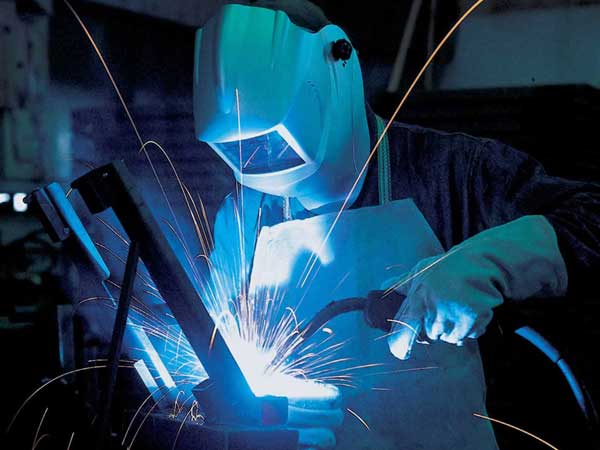
WHAT IS MIG WELDING?
MIG welding was developed in the 1940's and 60 years later the general principle is still very much the same. MIG welding uses an arc of electricity to create a short circuit between a continuously fed anode (+ the wire-fed welding torch) and a cathode ( - the metal being welded)
The heat produced by the short circuit, along with a non-reactive (hence inert) gas locally melts the metal and allows them to mix together. Once the heat is removed, the metal begins to cool and solidify, and forms a new piece of fused metal.
A few years ago the full name - Metal Inert Gas (MIG) welding was changed to Gas Metal Arc Welding (GMAW) but if you call it that most people won't know what the you are talking about - the name MIG welding has certainly stuck.
MIG welding is useful because you can use it to weld many different types of metals: carbon steel, stainless steel, aluminium, magnesium, copper, nickel, silicon bronze and other alloys.
Here are some advantages to MIG welding:
The ability to join a wide range of metals and thicknesses
All-position welding capability
A good weld bead
A minimum of weld splatter
Easy to learn
Here are some disadvantages of MIG welding:
MIG welding can only be used on thin to medium thick metals
The use of an inert gas makes this type of welding less portable than arc welding which requires no external source of shielding gas. Produces a less controlled weld as compared to TIG (Tungsten Inert Gas Welding)
Video Reviews of our R-Tech I-Mig180 Mig Welder
Video Reviews of our R-Tech Pro-Mig250 Mig Welder


R-Tech Pro-MIG250-1 MIG Welder Review Part 1


R-Tech Pro-MIG250-1 MIG Welder Review Part 2


R-Tech Pro-MIG250-1 MIG Welder Review Part 3


R-Tech Pro-MIG250-1 MIG Welder Review Part 4


R-Tech Pro-MIG250-1 MIG Welder Review Part 5


R-Tech Pro-MIG250-1 MIG Welder Review Part 6


R-Tech Pro-MIG250-1 MIG Welder Review Part 7


R-Tech Pro-MIG250-1 MIG Welder Review Part 8


R-Tech Pro-MIG250-1 MIG Welder Review Part 9
How to Mig Weld Aluminium with a Spool Gun on the R-Tech MIG180
HOW DOES THE MIG WELDER WORK?
A MIG welder has a couple of different parts. If you open one up you will be able to see something like the pictures below
The Welder Inside the welder you will find a spool of MIG wire and a series of rollers that pushes the wire out to the welding torch. There isn't much going on inside this part of the welder, so it's worth it to take just a minute and familiarize yourself with the different parts. If the wire feed jams up for any reason you will want to check this part of the machine out. On larger power MIG welders you the wire feed unit can be separate as in pictures below. A welder with internal feed assembly is commonly known as a compact MIG welder.
The large spool of wire should be held on with a tension nut. The nut should be tight enough to keep the spool from unravelling so to avoids over-run (birds nesting) when trigger released, but not so tight that the rollers can't pull the wire from the spool.
If you follow the wire from the spool you can see that it goes into a set of rollers that pull the wire off of the big roll, this then pushes the wire up to the torch to the tip ready for welding.
The Gas Supply Assuming you are using a shielding gas with your MIG welder there will be a cylinder of gas behind the MIG. This is either 100% Argon or a mixture of CO2 and Argon. This gas shields the weld as it forms. Without the gas your welds will look brown, splattered and just generally not very nice. Open the main valve of the cylinder and make sure that there is some gas in it. Your gauges should be reading between 0 and 2500 PSI in the tank and the regulator should be set between 15 and 25 PSI depending on how you like to set things up and the type of welding torch you are using. When welding in areas with a draught you may need to run more gas pressure to avoid getting porosity in the weld.
Once the wire passes through the rollers it is sent down a set of hoses which lead to the welding torch. The hoses carry the charged electrode and the argon gas.
The Welding Torch The welding torch is the business end of things. It's where most of your attention will be directed during the welding process. The MIG torch consists of a trigger that controls the wire feed and the flow of electricity. The wire is guided by a replaceable copper tip that is made for each specific welder. Tips vary in size to fit whatever diameter wire you happen to be welding with. Most likely this part of the welder will already be set up for you. The outside of the tip of torch is covered by a metal shroud which protects the electrode and directs the flow of gas out the tip of the torch.
The Earth Clamp The earth clamp is the cathode (-) in the circuit and completes the circuit between the welder, the welding torch and the project. It should either be clipped directly to the piece of metal being welding or onto a metal welding table like the one pictured below.
The earth clamp must be making good contact with the piece being welded for it to work so be sure to grind off any rust or paint that may be preventing it from making a connection with your work.
MIG Welder wire feed unit assembly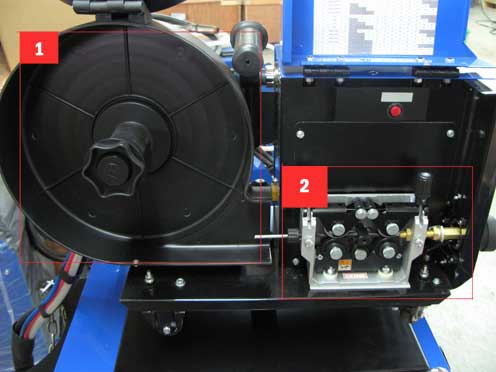
1. This is the spool holder where wire reel goes that feeds the welder. The wire comes off the spool (1), is pushed through the feeder (2) and travels out to the welding torch.
2. These are the rollers that pull the wire off the spool and send it out to the welding torch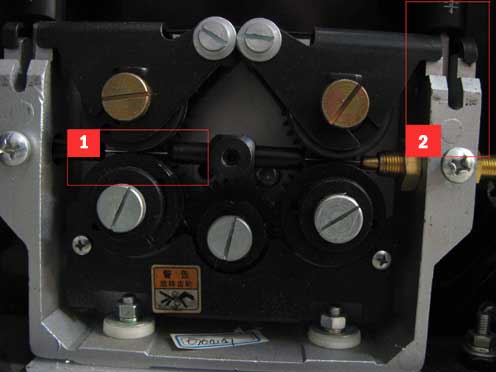
MIG welder 4 roll geared wire feed assembly
Wire being fed through the rollers 2. Tensioning Adjustment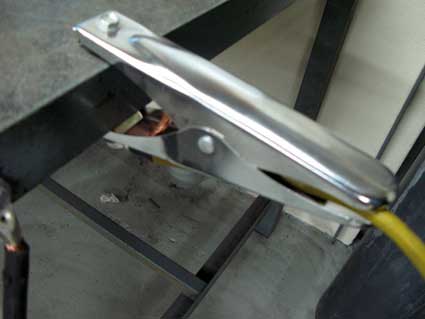
MIG welding earth clamp
Clamp the negative lead from the welder onto your project or, in this case, the welding table
SAFTEY GEAR
MIG welding can be a pretty safe thing to do so long as you follow a few important safety precautions. Because of MIG welding produces lots of heat and lots of harmful light, you need to take a few steps to protect yourself.
The light that is generated by any form of arc welding is extremely bright. It will burn your eyes and your skin just like the sun will if you don't protect yourself. The first thing you will need to weld is a welding helmet. I am wearing an auto-darkening welding mask below. They are really helpful if you are going to do a lot of welding and make a great investment if you think you will be working with metal often. Manual masks require you to jerk your head dropping the mask into position or require to use a free hand to pull the mask down. This allows you to use both your hands to weld, and not worry about the mask. Think of protecting others from the light as well and use a welding screen if it's available to make a border around yourself. The light has a tendency to draw on lookers who might need to shielded from being burned too.
Wear gloves and leathers to protect yourself from molten metal splattering off of your work piece. Some people like thin gloves for welding so you can have a lot of control. In TIG welding this is especially true, however for MIG welding you can wear whatever MIG welding gloves you feel comfortable with. The leathers will not only protect your skin from the heat produced by welding but they will also protect your skin from the UV light produced by welding. If you are going to be doing any amount of welding more than just a minute or two you will want to cover up because UV burns happen fast!
If you are not going to wear leathers at least make sure that you are wearing clothing made from cotton. Plastic fibers like polyester and rayon will melt when they come into contact with molten metal and will burn you. Cotton will get a hole in it, but at least it won't burn and make hot metal goop.
Do not wear open toed shoes or synthetic shoes that have mesh over the top of your toes. Hot metal often falls straight down and I have burned many holes through the tops of my shoes. Molten metal + hot plastic goo from shoes = no fun. Wear leather shoes or boots if you have them or cover your shoes in something non-flammable to stop this.
Weld in a well ventilated area. Welding produces hazardous fumes which you shouldn't breathe in if you can avoid it. Wear either a mask, or a respirator if you are going to be welding for a prolonged amount of time.
Important Safety Warning - DO NOT WELD GALVANIZED STEEL. Galvanized steel contains a zinc coating that produces carcinogenic and poisonous gas when it is burned. Exposure to the stuff can result in heavy metal poisoning (welding shivers) - flu like symptoms that can persist for a few days, but that can also cause permanent damage
Fire Fire Fire - Molten metal can spit several feet from a weld. Grinding sparks are even worse. Any sawdust, paper or plastic bags in the area can smolder and catch fire, so keep a tidy area for welding. Your attention will be focused on welding and it can be hard to see what's going on around you if something catches fire. Reduce the chance of that happening by clearing away all flammable objects from your weld area.
Keep a fire extinguisher beside the exit door from your workshop. CO2 is the best type for welding. Water extinguishers are not a good idea in a welding shop since you are standing next to a whole lot of electricity.
MIG welding clothing and mask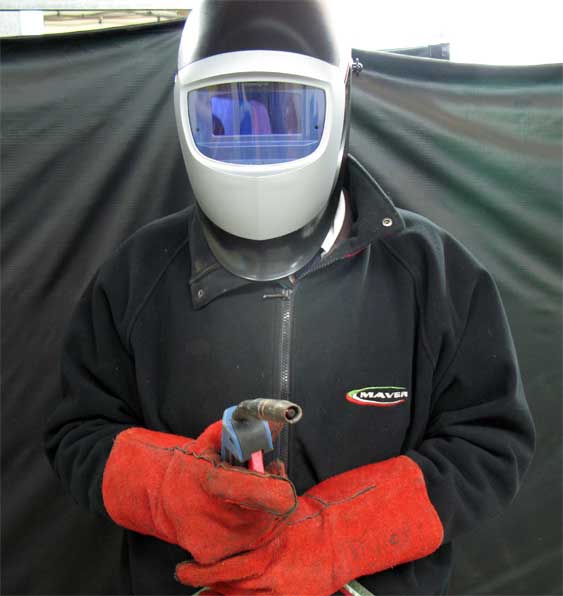
Gloves, auto-darkening helmet and a suitable cotton based jacket are essential to keep safe
PREPARING FOR THE WELD
Before you start welding make sure things are properly setup at both the welder and on the piece you are about to weld.
The Welder - Check to make sure that the valve to the shielding gas is open and that you have around 14LPM flowing through the regulator. The welder needs to be turned on, ground earth clamp attached to your welding table or to the metal directly and you need to have the right combination of welding power and wire feed speed
The Metal - While you can pretty much just take a MIG welder, squeeze the trigger and and touch it to your work piece to weld you won't get a great result. If you want the weld to be strong and clean, taking 5 minutes to clean your metal and grind down any edges that are being joined will really help your weld.
In the picture below an angle grinder is being used to bevel the edges of some square tube before it gets welded onto another piece of square tubing. By creating two bevels on the joining edges it makes a little valley for the weld pool to form in. Doing this for butt welds (when two things are pushed together and joined) is a good idea.
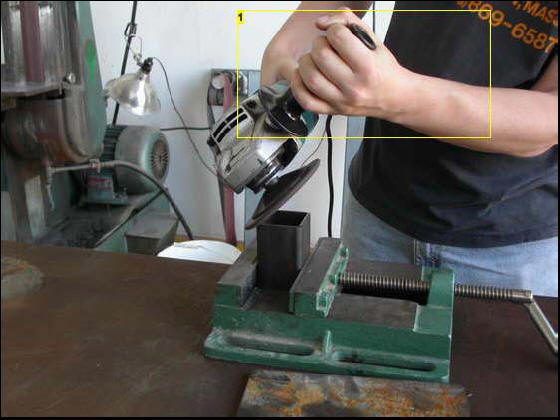
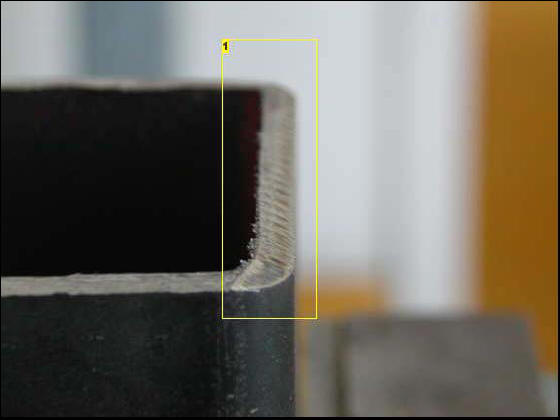
Bevel edge to metal before MIG welding, Gloves should be worn as this is a staged picture on the left. The right hand picture shows a neat bevelled edge which is required for your work prior to welding
LAYING A BEAD
Once your welder is set up and you have prepped your piece of metal it's time to start focusing on the actual welding
If it's your first time welding you might want to practice just running a bead before actually welding two pieces of metal together. You can do this by taking a piece of scrap metal and making a weld in a straight line on its surface.
Do this a couple of times before you start actually welding so that you can get a feel for the process and figure out what wire speed and power settings you will want to use.
Every welder is different so you will have to figure these settings out yourself. Too little power and you will have a splattered weld that won't penetrate through your work piece. Too much power and you might melt right through the metal entirely.
The pictures below show a few different beads being laid down on some 1/4" plate. Some have too much power and some could use a little more. See the image notes for the details.
The basic process of laying a bead is not too difficult. You are trying to make a small zig zag with the tip of the welder, or little concentric circles moving your way from the top of the weld downward. I like to think of it as "sewing" motion where I use the tip of the welding torch to weave the two pieces of metal together.
First start laying beads about an inch or two long. If you make any one weld too long your work piece will heat up in that area and could become warped or compromised, so it's best to do a little welding in one spot, move to another, and then come back to finish up what's left in between.
What are the right settings?
If you are experiencing holes in your work than your power is turned up too high and you are melting through your welds.
If your welds are forming in spurts your wire speed or power settings are too low. The torch is feeding wire out of the tip, it's then making contact, and then melting and splattering without forming a proper weld.
You'll know when you have settings right because your welds will start looking nice and smooth. You can also tell a fair amount about the quality of the weld by the way it sounds. You want to hear continuous sparking. Some welders says it sounds like an egg frying!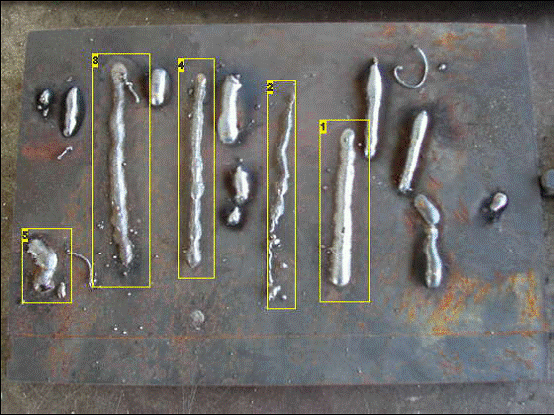
MIG welding Test welds Image Notes
1. These settings are pretty good.
2. Not enough power, not enough wire feed.
3. Good wire feed, not enough power.
4. Good wire feed, not enough power.
5. It takes a little while to get comfortable, don't be afraid to make some test welds to get a feel for it.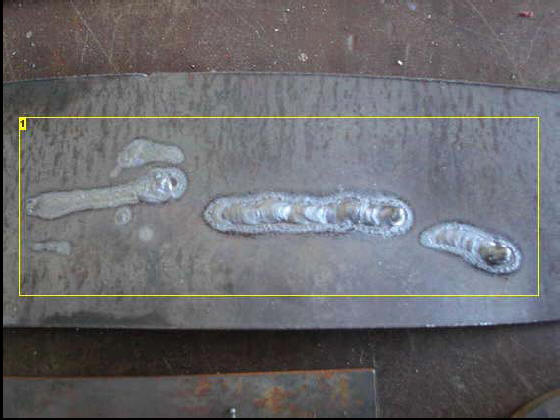
Image Notes 1. These are similar power and feed settings, but tested on a much thinner sheet of steel plate. As you can see the weld has penetrated very deeply and is starting to deform the piece. You can see some curling on the sides of the plate.
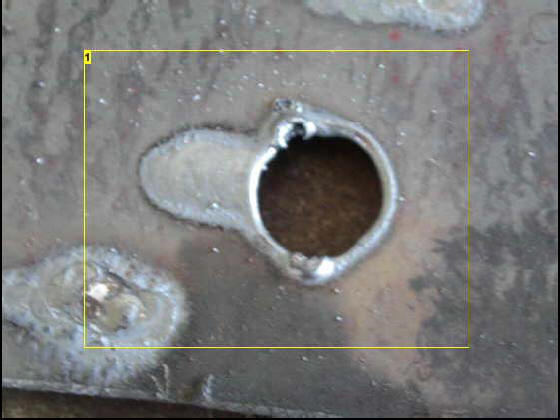
Image Notes 1. Too much power has created a burn hole in the metal
WELDING METAL TOGETHER
Once you've got your method tested out a bit on some scrap, it's time to do the actual weld. In this photo I am doing just a simple butt weld on some square stock. We've already ground down the edges of the surfaces that are going to be welded so that the seam where they meet makes a small "v".
We are basically just taking the welder and making our sewing motion across the top of the seam. It's ideal to weld from the bottom of the stock up to the top, pushing the weld forward with the tip of the torch, however that isn't always comfortable or a good way to start learning. In the beginning it's perfectly fine to weld in whatever direction/position that is comfortable and that works for you.
Once we finished welding the pipe we were left with a big bump where the filler came in. You can leave that if you like, or you can grind it flat depending on what you are using the metal for. Once we ground it down we found one side where the weld didn't penetrate properly. (See photo 3.) That means that we need to have more power and more wire to fill in the weld. We went back and redid the weld so that it was properly joined.
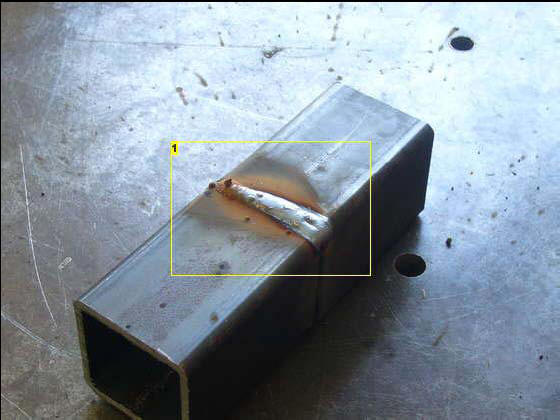
Image Notes 1. This was our first try. Not a bad weld, but we could probably use a little more gas and a little less power. This weld penetrated pretty deeply.
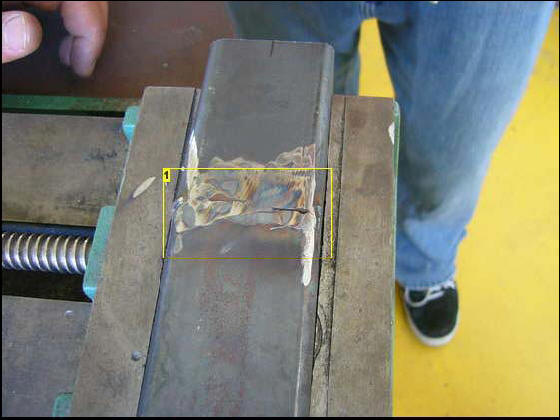
Image Notes 1. This side of the square stock wasn't welded with enough power because the weld didn't penetrate all the way through. Notice the blue hue to the metal around the seam. That means that we were pushing too hard with the angle grinder when we were grinding down the weld. Remember to keep the disc moving and to resist the urge of trying to cut corners while grinding. It's sometimes a slow process that requires patience.
GRINDING DOWN THE WELD
If your weld isn't on a piece of metal that will show, or if you don't care about how the weld looks, then you are done with your weld. However, if the weld is showing or you are welding something that you want to look nice then you will most likely want to grind down your weld and smooth it out.
Put a grinding wheel onto an angle grinder and get started grinding on the weld. The neater your weld was the less grinding you will have to do, and after you have spent a whole day grinding, you will see why it's worth it to keep your welds neat in the first place. If you use a ton of wire and made a mess of things it's ok, it just means that you might be grinding for a while. If you had a neat simple weld though, then it shouldn't take too long to clean things up.
Be careful as you approach the surface of the original stock. You don't want to grind through your nice new weld or gouge out a piece of the metal. Move the angle grinder around like you would a sander so as not to heat up, or grind away any one spot of the metal too much. If you see the metal get a blue tinge to it you are either pushing too hard with the grinder or not moving the grinding wheel around enough. This is can happen especially easily while grinding thin sheets of metal.
Grinding welds can take a while to do depending on how much you have welded and can be a tedious process - take breaks while grinding and stay hydrated, (grinding rooms in shops or studios tend to heat up, especially if you are wearing leathers). Wear a full face mask when grinding, a mask or respirator, and ear protection. Make sure that all your clothing is neatly tucked in and that you don't have anything hanging down from your body that could get caught in the grinder - it spins fast and it can suck you in!
When you have finished you should end up with something similar to the photo on the right hand side
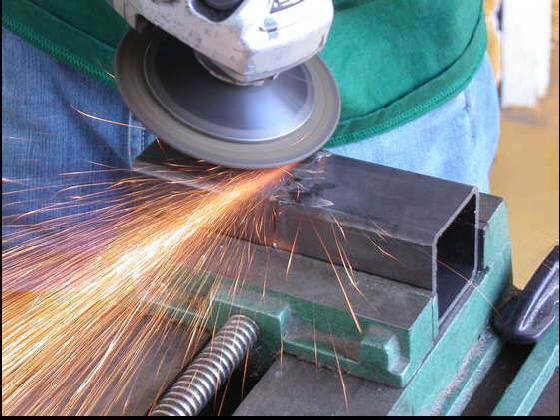
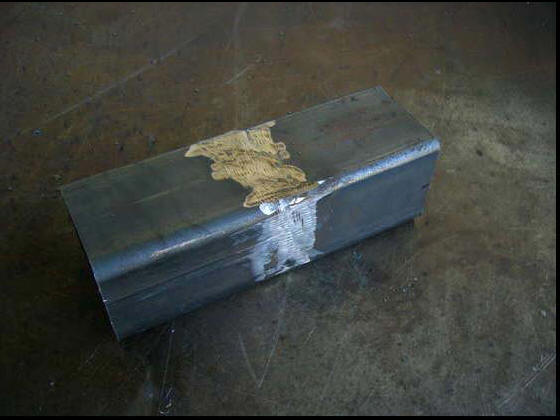
COMMON PROBLEMS
It can take a good amount of practice to start welding reliably every time, so don't worry if you have some problems when you first stop. Some common problems are:
No or not enough shielding gas from the torch is surrounding the weld. You can tell when this happens because the weld will start splattering little balls of metal, and will turn nasty colours of brown and green you can also see air bubbles on top of the weld (porosity). Turn up the pressure on the gas and see if that helps.
Weld is not penetrating. This is easy to tell as your weld will be weak and won't be fully joining your two piece of metal. Try more power and wire speed.
Weld burns a while right through your material. This is caused by welding with too much power. Simply turn down your welding power and it should go away.
Too much metal in your weld pool or the weld is sloppy like porridge. This is caused by too much wire coming out of the torch and can be fixed by slowing down your wire speed.
Poor weld penetration, erratic weld. Check condition of earth clamp and ensure where it fits to bench is clean and free from rust/paint. If earth clamp shows signs of overheating fit new clamp or complete lead assy
Welding torch spits and does not maintain a constant weld. This could be caused because the torch is too far from the weld.
You want to hold the tip of the torch about 1/4" to 1/2" away from the weld.
WELDING WIRE TO THE TIP/CHANGING THE TIP
Sometimes if you are welding too close to your material or you are building up too much heat the tip of the wire can actually weld itself onto the tip of your welding torch. This looks like a little blob of metal at the tip of your torch and you'll know when you have this problem because the wire won't come out of the torch anymore. Fixing this is reasonably simple if you just pull on the blob with a set of pliers. See photos below.
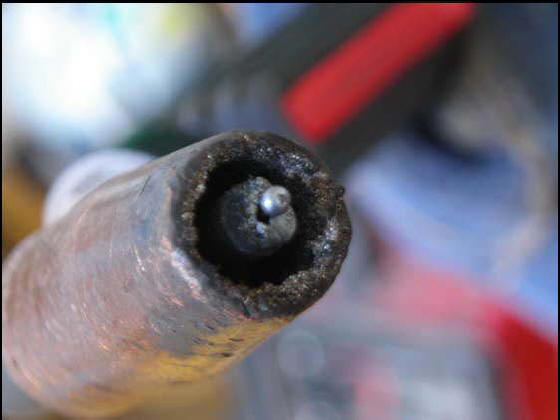
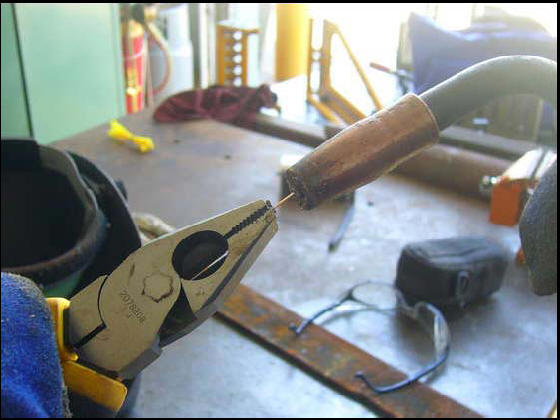
If you really scorch the tip of your torch and fuse the hole closed with metal then you need to turn the welder off and replace the tip. Follow the photo series below to see how it's done.
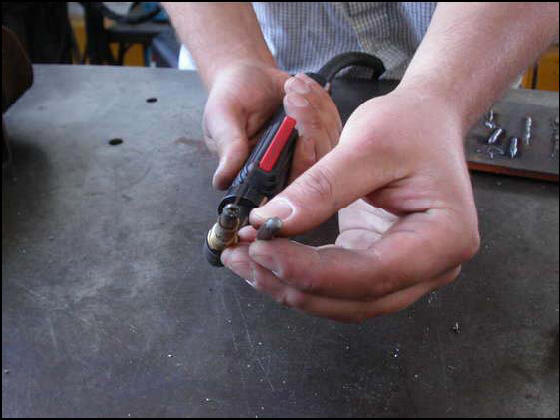
1. The tip is fused closed
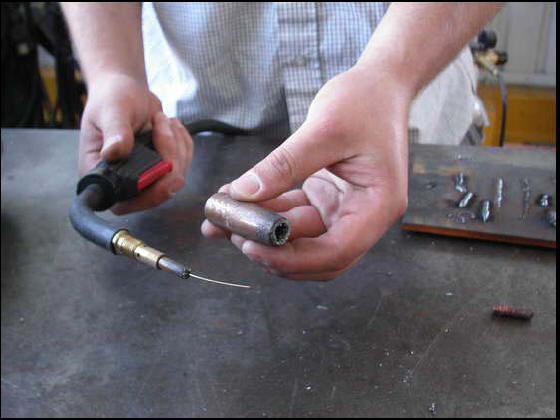
2. Unscrew the welding shield cup.
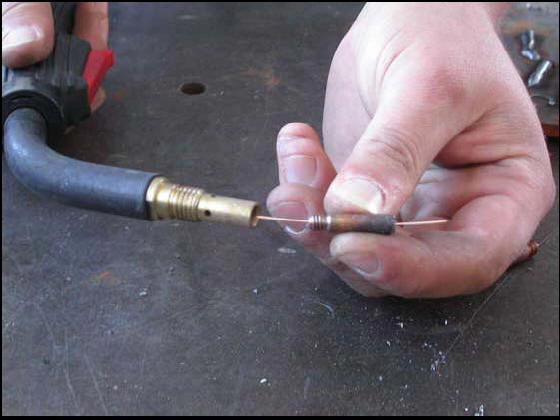
3. Unscrew the bad welding tip
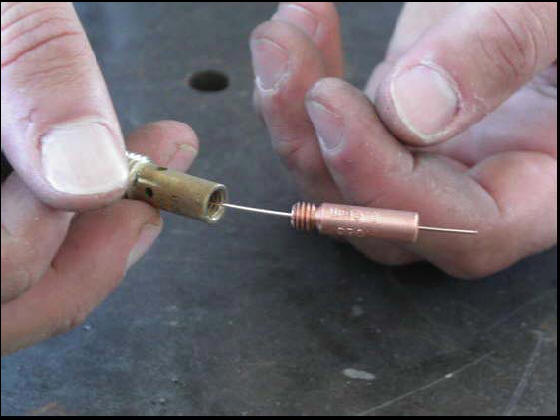
4. Slide a new tip into place.
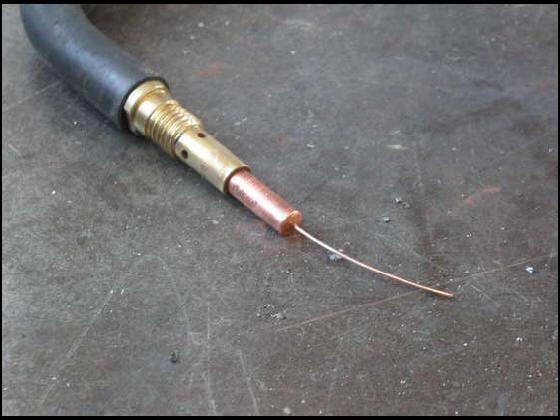
5. Screw the new tip on
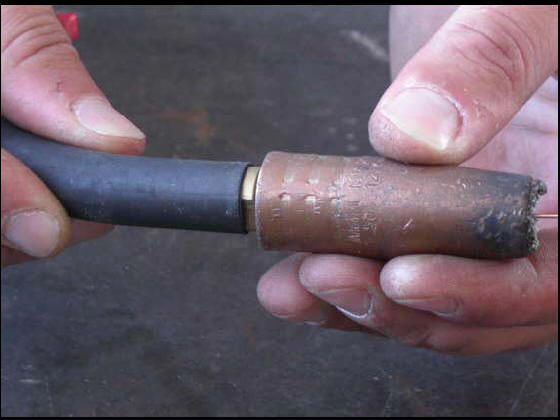
6. Replace the welding cup
Listed below are some features found on advanced MIG welders with their explanation.
Arc force
This controls the penetration of the weld via a control knob on machine (On older machines this was known as choke, you may have 2-3 connectors for the earth cable)
Low setting = Less penetration and low splatter, used for thinner materials. This really helps when welding car bodywork! High setting = High penetration and more splatter (harsher weld), used for thicker materials.
Spot Welding
This allows you to set an amount of time machine will weld when trigger is pressed. When you press the trigger a spot weld is carried out and then machine stops, release and press trigger again to produce another spot weld.
Stich Welding
This is similar to spot welding but with the addition of stitch time which sets the interval between spots. So as you press the trigger a spot weld is done as set by spot welder control knob and then a delay set by the stitch control knob and then another spot weld is produced, this will carry on until the torch trigger is released.
Push Pull torch
This is a MIG torch used for aluminium welding. The torch head has a pair of rollers driven by a motor which pulls the wire as well as the MIG welder roller system pushing the wire. This ensures correct wire feed of the softer alloy wire and prevents snags and wire feed problems. Generally used for production alloy MIG welding.
Soft Start
When the trigger is pressed the wire comes out of the torch slowly (slower than set wire feed speed), when the wire touches the work the arc is started. The machine senses this and increases the wire feed to set speed. This can stop torch jerk when starting a weld and also produces a better start to the weld.
4-Roll Wire feed assembly
Smaller and DIY machines normally come with a 2-roll feed system, this comprises of a bottom roller with grooves in and a top pressure roller which is flat and puts pressure on wire as set by tensioners to drive wire when the rollers turn.
A 4-Roll system has two bottom rollers and two top rollers which give a more stable wire feed and is better at feeding softer alloy wires than a 2-roll system. Some MIG welders also have geared 4-roll systems which help to regulate wire flow speed with great accuracy resulting in exceptionally smooth welds. The pictures at the front of this guide show a 4-roll geared version.





